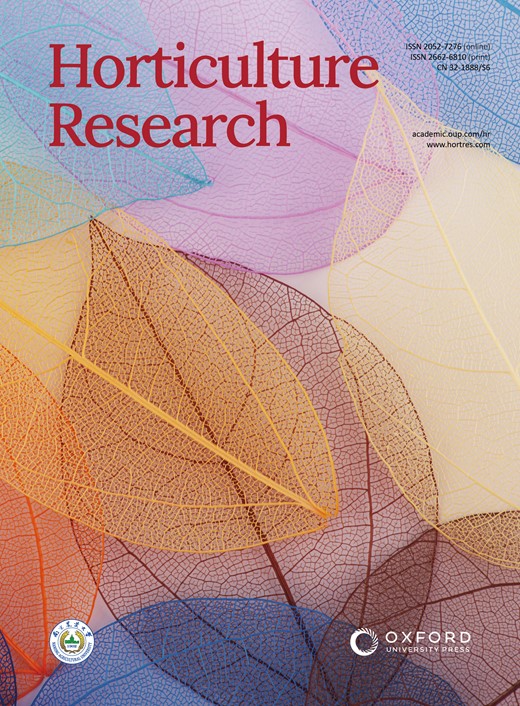C型凝集素受体样激酶CsTs调控黄瓜(Cucumis sativus)的毛状体发育和角质层代谢
IF 8.7
1区 农林科学
Q1 Agricultural and Biological Sciences
引用次数: 0
摘要
黄瓜(Cucumis sativus)果刺是研究多细胞毛状体发育的经典材料。一些影响毛状体发育的关键基因已被证实与角质层生物合成和次生代谢有关。然而,人们对黄瓜毛状体发育、角质层生物合成和次生代谢的生物机制仍然知之甚少。黄瓜(Cucumis sativus)果刺是研究多细胞毛状体发育的经典材料。一些影响毛状体发育的关键基因已被证实与角质层生物合成和次生代谢有关。然而,人们对黄瓜毛状体发育、角质层生物合成和次生代谢的生物学机制仍然知之甚少。据报道,CsTs 是一种 C 型凝集素受体样激酶基因,当它发生突变时会导致黄瓜出现柔嫩的毛状体表型。本研究利用基因编辑技术证实了 CsTs 在黄瓜果刺形态发生中的作用。通过切片技术和细胞壁成分检测,分析了ts突变体果刺细嫩的主要原因。随后,利用转录组数据和一系列分子生物学实验进一步研究了CsTs与黄瓜细胞骨架平衡的关系。CsTs的过表达部分补偿了拟南芥同源突变体的异常毛状体表型。基因杂交和代谢分析表明,CsTs 和 CsMcit 可通过相同的途径影响毛状体的发育和角质层的生物合成。我们的发现为今后研究黄瓜毛状体发育的分子机制提供了重要的背景信息,并有助于理解C型凝集素受体样激酶的生物学功能。本文章由计算机程序翻译,如有差异,请以英文原文为准。
CsTs, a C-type lectin receptor-like kinase, regulates the development trichome development and cuticle metabolism in cucumber (Cucumis sativus)
Cucumber (Cucumis sativus) fruit spines are a classic material for researching the development of multicellular trichomes. Some key genes that influence trichome development have been confirmed to be associated with cuticle biosynthesis and secondary metabolism. However, the biological mechanisms underlying trichome development, cuticle biosynthesis, and secondary metabolism in cucumber remain poorly understood. Cucumber (Cucumis sativus) fruit spines are classic material for researching the development of multicellular trichomes. Some key genes that influence trichome development have been confirmed to be associated with cuticle biosynthesis and secondary metabolism. However, the biological mechanisms underlying trichome development, cuticle biosynthesis, and secondary metabolism in cucumber remain poorly understood. CsTs, a C-type lectin receptor-like kinase gene, reportedly causes a tender trichome phenotype in cucumber when it mutates. In this study, the role of CsTs in cucumber fruit spine morphogenesis was confirmed using gene editing technology. Sectioning technology and cell wall component detection were used to analyze the main causes of tender fruit spines in the ts mutant. Subsequently, transcriptome data and a series of molecular biology experiments were used to further investigate the relationship between CsTs and cytoskeletal homeostasis in cucumber. CsTs overexpression partially compensated for the abnormal trichome phenotype of an Arabidopsis homolog mutant. Genetic hybridization and metabolic analysis indicated that CsTs and CsMcit can affect trichome development and cuticle biosynthesis using the same pathway. Our findings provide important background information for future research on the molecular mechanism underlying cucumber trichome development and contribute to understanding the biological function of C-type lectin receptor-like kinases.
求助全文
通过发布文献求助,成功后即可免费获取论文全文。
去求助
来源期刊

Horticulture Research
Biochemistry, Genetics and Molecular Biology-Biochemistry
CiteScore
11.20
自引率
6.90%
发文量
367
审稿时长
20 weeks
期刊介绍:
Horticulture Research, an open access journal affiliated with Nanjing Agricultural University, has achieved the prestigious ranking of number one in the Horticulture category of the Journal Citation Reports ™ from Clarivate, 2022. As a leading publication in the field, the journal is dedicated to disseminating original research articles, comprehensive reviews, insightful perspectives, thought-provoking comments, and valuable correspondence articles and letters to the editor. Its scope encompasses all vital aspects of horticultural plants and disciplines, such as biotechnology, breeding, cellular and molecular biology, evolution, genetics, inter-species interactions, physiology, and the origination and domestication of crops.
 求助内容:
求助内容: 应助结果提醒方式:
应助结果提醒方式:


